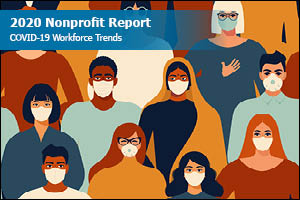
While we continue to adjust to this new “normal” of working remotely—with little to no face-to-face interaction—the COVID-19 pandemic has taken a major toll on nonprofit employees and their mental health.
This informative webinar provides helpful tips on how nonprofit leaders can help keep employees productive and engaged in day-to-day work activities. Watch now to learn key strategies that include:
For more access to nonprofit specific how-to guides, checklists and resources? Sign up for UST’s monthly eNews today!

In a recent nonprofit survey, UST uncovered how COVID-19 has affected 501(c)(3) nonprofit organizations, their employees and operational strategies.
With nearly 800 survey respondents—representing a wide variety of nonprofits from across the U.S.—this report highlights critical COVID-19 information, including:
This report will provide valuable insight on how nonprofit organizations are coping with the unprecedented challenges during this pandemic. Download your complimentary copy today.

Question: What’s the difference between a furlough and a layoff?
Answer: First, you should note that the language used when sending employees home for a period of time is less important than communicating your actual intent. Since temporary layoffs and furloughs are only used regularly in certain industries (usually seasonal), you should not assume that employees will know what they mean. Be sure to communicate your plans for the future, even if they feel quite uncertain or are only short-term.
Furlough
A furlough continues employment but reduces scheduled hours or requires a period of unpaid leave. The thought process is that having all employees incur a bit of hardship is better than some losing their jobs completely. For example, a company may reduce hours to 20 per week for a period of time as a cost-saving measure, or they may place everyone on a two-week unpaid leave. This is typically not considered termination; however, you may still need to provide certain notices to employees about the change in the relationship, and they would likely still be eligible for unemployment.
If the entire company won’t be furloughed, but only certain employees, it is important to be able to show that staff selection is not being done for a discriminatory reason. You’ll want to document the nondiscriminatory business reasons that support the decision to furlough certain employees and not others, such as those that perform essential services.
Layoff
A layoff involves terminating employment during a period when no work is available. This may be temporary or permanent. If you close down completely, but you intend to reopen in the relatively near future or have an expected reopening date — at which time you will rehire an employee, or all employees — this would be considered a temporary layoff. Temporary layoffs are appropriate for relatively short-term slowdowns or closures. A layoff is generally considered permanent if there are no plans to rehire the employee or employees because the slowdown or closure is expected to be lengthy or permanent.
Pay for exempt employees (those not entitled to overtime)
Exempt employees do not have to be paid if they do no work at all for an entire workweek. However, if work is not available for a partial week for an exempt employee, they must be paid their full salary for that week, regardless of the fact that they have done less work. If the point is to save money (and it usually is), it’s best to ensure that the layoff covers the company’s established seven-day workweek for exempt employees. Make it very clear to exempt employees that they should do absolutely no work during any week you’re shut down. If exempt employees do any work during that time, they will need to be paid their normal weekly salary.
Pay for nonexempt employees (those entitled to overtime)
Nonexempt employees only need to be paid for actual hours worked, so single day or partial-week furloughs can be applied to them without worrying about pay implications. We recommend that you engage in open communication with the affected employees before and during the furlough or temporary layoff period.
Q&A provided by ThinkHR, powering the UST HR Workplace for nonprofit HR teams. Have HR questions? Sign your nonprofit up for a free 30-day trial today.

Nonprofits are facing unprecedented challenges navigating COVID-19 and its impact on day-to-day operations. Our recent webinar was designed to provide some valuable insight into the latest unemployment legislation and its impact on your organization and its employees.
This informative webinar recording discusses how COVID-19 is impacting nonprofits nationwide, what alternatives there are to layoffs and/or workforce reductions and more. Watch now to discover:
For additional COVID-19 employer resources and FAQs, please visit our COVID-19 Resource Center today!

Here at UST, we understand the importance for nonprofit leaders to remain informed and prepared as the recent outbreak of the Coronavirus continues to impact the communities you serve. Nonprofit organizations nationwide have had to react quickly to a rapidly evolving crisis and change their standard business practices to maintain critical operations.
Like so many of you, we have transitioned to remote work and are continuously gathering resources to stay on top of the quickly evolving legislative developments designed to mitigate the economic fallout triggered by the public health response. We’ve also been in close contact with our strategic partners nationwide to ensure that the unique needs of nonprofit employers are being prioritized by our elected representatives during this time.
In an effort to help keep nonprofits abreast of evolving information, we’ve created a dedicated COVID Resources Webpage on our website, which we’ll continuously update, provides:
We’ll continuously be updating this page so please check back regularly and bookmark the page above for easy reference. UST has been supporting nonprofit employers for over 35 years and understand the value of being informed during times of uncertainty and challenge. Please know our thoughts are with all who have been impacted by the recent outbreak of COVID-19 and we’re here to answer any questions you may have.

Terminating an employee is stressful for everyone involved and many managers and human resource professionals consider this responsibility the worst part of their job—whether as a layoff, a bad hire or for cause. With a little planning and preparation, you can make the experience less traumatic for everyone, maintain compliance with state and federal law, ensure your employee feels respected and avoid any bad publicity.
Organizations are under strict protocol when it comes to terminating employees and should therefore have written procedures in place to avoid negative repercussions such as fines and or lawsuits. Get ahead of issues as soon as possible by having open conversations on how to improve performance, attitude, or other matters so as not to blindside employees when the decision is made to let them go. Never take allegations as fact—conduct thorough investigations, secure findings and always document performance and behavioral issues as well as any disciplinary actions taken.
Following are some do’s and don’ts to consider when preparing to terminate an employee.
Tips on how to approach, conduct and communicate a termination:
Mistakes to avoid when terminating an employee:
Termination meetings are uncomfortable and come with risks but you can make the experience more palatable by preparing an effective and supportive approach to a hard conversation. The last 15 minutes you spend terminating an employee will likely be the most important of the employment relationship, so ensure you’ve covered your bases to avoid negative outcomes that could harm your organizations reputation.

For over three decades, UST has been providing nonprofits with workforce solutions that help manage unemployment funding, ensure compliance, and maximize employee bandwidth. By offering cost-effective services, reliable protection and significant savings, UST allows nonprofits nationwide to save valuable time and money.
As part of UST’s ongoing efforts to educate nonprofits we recently released our newest animated short video designed to provide a holistic overview of UST. About a minute long, this video reveals how nonprofit employers can streamline their day-to-day processes with simplified programs and dedicated support—including HR consultants, on-demand training modules, unemployment claims representatives, and career transition services.
UST already helps more than 2,200 participating nonprofits make the most of their resources to achieve their mission-driven initiatives. And, just last year, identified $2,707,750 in potential unemployment cost savings for 103 eligible nonprofit organizations. Watch the video today to discover how UST can benefit your nonprofit, your employees and the communities you serve.
For access to nonprofit specific how-to-guides, checklists and resources, sign up for UST’s monthly eNews today!

Question: Can you provide some tips for developing and conducting an employee engagement survey?
Answer: An employee engagement survey can be a great tool to check the temperature of your culture. When done right, the survey can help you understand the needs of your employees, which in turn benefits productivity, job satisfaction, and supports employee retention. It is also an excellent tool to help you calibrate the quality of your leadership as well as your employee relations and talent management programs.
Before you start, however, ensure that the management team is ready to act on the critical feedback you’ll get. Then decide what it is you need to know. Do you want to better understand how your employees view their relationship with management, understand and support the company’s strategic direction, or learn what aspects of their work environment, compensation and benefits, work assignments, and opportunities for learning and advancement are working (or not working)?
Next, determine how you will create, disseminate, tabulate, and communicate the survey process and results. If you’re creating your own survey, consider gathering employees from different areas of the company to formulate the survey questions and include them in the employee communications process to encourage participation. This team can also be instrumental in reviewing the survey results and providing feedback about how those results should be communicated and acted upon.
Another option is to use one of the many online engagement survey tools available in the marketplace. While the questions may not be as personalized to your company issues, you can get the surveys, along with the tabulated results, done quickly.
If you do create the survey in-house, consider these best practice tips:
Encourage participation by using incentives or contests. With more feedback, you’ll have a better picture of your employees’ engagement level. Train your leaders so that they are prepared to use the survey feedback as a gift to improve performance and have productive feedback and performance improvement planning sessions.
Most importantly, don’t ask for employee feedback unless you are willing to do something with the results. Your employees will expect you to implement changes and take action. Let them know how much you value and respect them by listening and acting on their opinions and ideas.
Q&A provided by ThinkHR, powering the UST HR Workplace for nonprofit HR teams. Have HR questions? Sign your nonprofit up for a free 30-day trial here.

It’s that time of year again when we can expect to experience some inclement weather conditions across the states. When severe weather interferes with the day-to-day operations of your nonprofit, having a plan in place for unexpected barriers to your workflow can help to keep your organization productive and or reestablish business operations sooner than later if you are forced to shut down.
Severe weather increases the risk of power outages—knocking out heat, power and communication services—and often for extended periods. Many employers find themselves dealing with a number of weather related inconveniences they hadn’t even considered until it happens to them. While there are no federal or state laws that define how a company should handle such things as notifying employees of office closures or how to handle pay for missed workdays, that doesn’t mean it shouldn’t be a priority.
By taking a proactive approach now, you can avoid the headache later—scrambling to figure out what to do and where even to begin. You can start by creating a plan that includes policies for what to do before, during and after emergencies—ensuring that everyone in the organization has a role and understanding of the policies once finalized.
Below are some tips to help ensure your nonprofit and its employees are prepared:
Regardless of what weather incident you may experience, having a solid preparedness plan in place will help ensure your employees know what to expect and aid in keeping everyone informed. There are dozens of websites dedicated to helping businesses create successful preparedness plans so just remember—a little preparation now will go a long way should your nonprofit come face-to-face with Mother Nature.

UST maintains a secure site. This means that information we obtain from you in the process of enrolling is protected and cannot be viewed by others. Information about your agency is provided to our various service providers once you enroll in UST for the purpose of providing you with the best possible service. Your information will never be sold or rented to other entities that are not affiliated with UST. Agencies that are actively enrolled in UST are listed for review by other agencies, UST’s sponsors and potential participants, but no information specific to your agency can be reviewed by anyone not affiliated with UST and not otherwise engaged in providing services to you except as required by law or valid legal process.
Your use of this site and the provision of basic information constitute your consent for UST to use the information supplied.
UST may collect generic information about overall website traffic, and use other analytical information and tools to help us improve our website and provide the best possible information and service. As you browse UST’s website, cookies may also be placed on your computer so that we can better understand what information our visitors are most interested in, and to help direct you to other relevant information. These cookies do not collect personal information such as your name, email, postal address or phone number. To opt out of some of these cookies, click here. If you are a Twitter user, and prefer not to have Twitter ad content tailored to you, learn more here.
Further, our website may contain links to other sites. Anytime you connect to another website, their respective privacy policy will apply and UST is not responsible for the privacy practices of others.
This Privacy Policy and the Terms of Use for our site is subject to change.
UST maintains a secure site. This means that information we obtain from you in the process of enrolling is protected and cannot be viewed by others. Information about your agency is provided to our various service providers once you enroll in UST for the purpose of providing you with the best possible service. Your information will never be sold or rented to other entities that are not affiliated with UST. Agencies that are actively enrolled in UST are listed for review by other agencies, UST’s sponsors and potential participants, but no information specific to your agency can be reviewed by anyone not affiliated with UST and not otherwise engaged in providing services to you except as required by law or valid legal process.
Your use of this site and the provision of basic information constitute your consent for UST to use the information supplied.
UST may collect generic information about overall website traffic, and use other analytical information and tools to help us improve our website and provide the best possible information and service. As you browse UST’s website, cookies may also be placed on your computer so that we can better understand what information our visitors are most interested in, and to help direct you to other relevant information. These cookies do not collect personal information such as your name, email, postal address or phone number. To opt out of some of these cookies, click here. If you are a Twitter user, and prefer not to have Twitter ad content tailored to you, learn more here.
Further, our website may contain links to other sites. Anytime you connect to another website, their respective privacy policy will apply and UST is not responsible for the privacy practices of others.
This Privacy Policy and the Terms of Use for our site is subject to change.